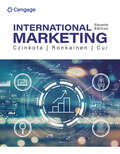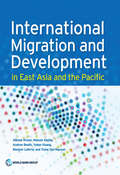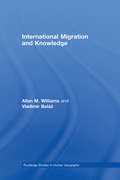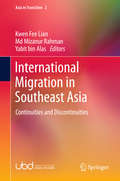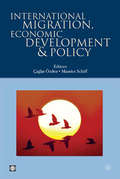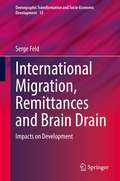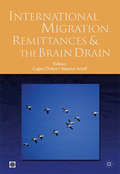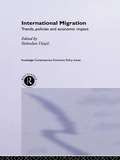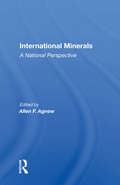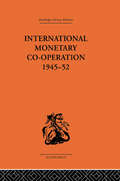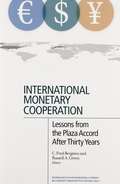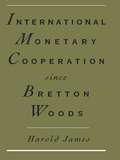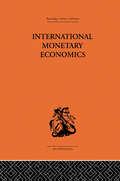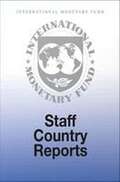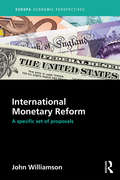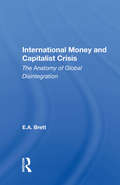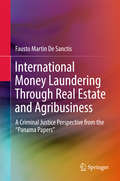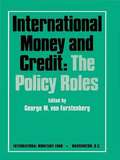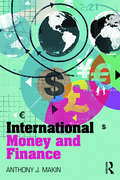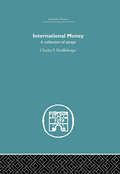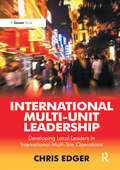- Table View
- List View
International Marketing: What Executives Need To Know
by Ilkka A. Ronkainen Michael R. Czinkota Annie Peng CuiExamine today's best practices and key issues impacting international marketing with the best-selling, upper-level international marketing text — Czinkota/Ronkainen/Cui's INTERNATIONAL MARKETING, 11E. <p><p>This innovative resource offers cutting-edge international marketing strategies and guidelines using the latest examples. You explore the range of international marketing topics, from start-up operations and new market entry considerations to key international issues confronting today's giant global marketers. Updates address international e-commerce and technology as well as the impact of culture and government on marketing throughout the world. Case studies highlight the latest marketing practices in real organizations, while Internet exercises focus on online opportunities. <p><p>This in-depth coverage prepares you for success in today's international business world, whether you are an upcoming international marketer or practicing executive.
International Migration and Development in East Asia and the Pacific
by Yukon Huang Manolo Abella Andrew Beath Manjula Luthria Ahmad Ahsan Trang Van NguyenThe East Asia and Pacific (EAP) region has an international emigrant population of more than 21 million people who remitted US$112 billion to their home countries in 2013. The region also hosts more than 7 million migrant workers, mostly from other Asian countries. These migrant workers account for 20 percent or more of the labor force in economies such as Malaysia and Singapore and thus play a significant role in the economies of the labor-receiving countries. An aging population in many East Asian countries will create significant labor shortages, leading to greater demand for migrant workers. For these reasons, international labor mobility is emerging as an important development issue in East Asia, with important implications for reducing poverty and supporting sustainable economic development in the region. In this context, International Migration and Development in East Asia and the Pacific analyzes the impact of migration on development of the EAP region and examines how international migration should be managed in East Asia in a way that supports development goals while simultaneously protecting the rights of migrants. The study covers trends in international migration in East Asia and overarching regional issues such as the links between macroeconomic management and remittances and the role of demographic trends in migration; the economic impact of migration and remittances on labor-sending countries and labor-receiving countries; the migration industry; and the policies and institutions that govern migration. This report shows that in labor-sending countries remittances help reduce poverty significantly by increasing income for migrants' families. At the country level, remittances have a significant role in helping finance trade deficits and in bolstering reserves, not only in the small Pacific Island economies but also in large economies such as Vietnam and the Philippines. For labor-receiving countries, such as Malaysia, Singapore, and Hong Kong SAR, China, migrant workers form a significant part of the workforce, especially in labor-intensive manufacturing, construction, plantation agriculture, fishing, and household services. Migrant workers thus help relieve labor shortages, boost output, and maintain competitiveness. The role of migrant workers will become more important in the future given the rapid population aging in many labor-receiving East Asian countries. Given these factors, the key question concerning international migration in East Asia and the Pacific is not whether it is desirable but how it should be managed in the future. International Migration and Development in East Asia and the Pacific discusses a range of policy options in both labor-sending and labor-receiving countries to address this question.
International Migration and Knowledge (Routledge Studies in Human Geography)
by Allan Williams Vladimir BalážTwo unconnected but important recent academic and policy debates have focussed on the idea of the knowledge-based economy and the economic consequences of increasing international migration. This book challenges pre-conceived views on the debates and argues the need to understand that all migrants are potentially knowledge carriers and learners, and that they play an essential role in the globalization of knowledge transactions. Deconstructing the concept of knowledge, and demonstrating how tacit knowledge is in fact an amalgam of encultured and embrained/embodied forms of knowledge this book considers how international migration has profound consequences, analysed, first, in terms of the economic and immigration strategies of national and regional bodies. And, secondly, the authors explore how the ‘diversity dividend’ of migration is captured by firms through their management strategies, and by individuals through increasingly boundaryless careers, continuous learning and transnational working lives. This research is a highly original contribution which provides the first overview of one of the most dynamic forces for change in the globalising economy. It will challenge migration researchers and students to engage with the management and learning literatures, and it will challenge management and economic policy analysts to think through the role of international migration. As such it will contribute to teaching and research in a range of social science disciplines, as well as to those involved in policy arenas ensuring that firms and all migrants engage in mutual learning and knowledge sharing.
International Migration in Southeast Asia
by Kwen Fee Lian Md Mizanur Rahman Yabit Bin AlasThis book is a collection of work by migration scholars and researchers who are actively conducting fieldwork in Southeast Asia. It presents a wide variety of current research and approaches the field of international labor migration from a regional perspective, acknowledging that the migration process goes beyond local and national boundaries and is embedded in regional and global interconnections. The chapters capture the complexity and richness of the migration phenomenon and experience, which manifests itself in a multitude of ways in a region well known for its diversity. The collection highlights the continuities and discontinuities in the linkages that have been forged through the movement of people between sending and receiving societies. Such linkages are explained by distinguishing between migration that has been sustained by a colonial past and migration that has been precipitated by globalization in the last two decades. The diversity of issues in the region covered by this volume will encourage a rethink of some of the conventional views of migration scholarship and result in a more critical reflection of how we approach migration research.
International Migration in the Age of Crisis and Globalization
by Andrés SolimanoThe international mobility of people and elites is a main feature of the global economy of today and yesterday. Immigration augments the labor force in receiving countries and provides many of the bodies and minds that are essential to any vibrant economy. Talented people are critical to the transfer of knowledge, ideas, fresh capital, contacts, and entrepreneurial capacities. This book is based on a blend of theory, varied country examples, and rich historical material ranging from the mid-nineteenth century to the early twenty-first century. It discusses the conceptual underpinnings of the push and pull factors of current migration waves and their impacts for development on the source and receiving countries. The analysis reviews the historical context under which various migration experiences have taken place - both in periods of internationalism and in periods of nationalism - in order to contribute to debates on the desirability of and tensions and costs involved in the current process of international migration and globalization. These issues are relevant during both times of economic slumps and times of economic growth.
International Migration, Economic Development & Policy
by Maurice Schiff Çaglar ÖzdenInternational migration has become a central element of international relations and global integration due to its rapidly increasing economic, social, and cultural impact in both source and destination countries. This book provides new evidence on the impact of migration and remittances on several development indicators, including innovative thinking about the nexus between migration and birth rates. In addition, the book identifies the effect of host country policies on migration flows, examines the determinants of return and repeat migration, and explores the degree of success of return migrants upon return to their country of origin.
International Migration, Remittances and Brain Drain: Impacts on Development (Demographic Transformation and Socio-Economic Development #13)
by Serge FeldThis book provides an analysis of theoretical and empirical researches on the effects of remittances and brain drain on the development of less developed countries (LDCs). It analyzes the most recent global, regional and national data as well as the arguments for and against the emigration of highly skilled personnel and remittances, thereby highlighting policies aimed at optimizing the link between migration and development. The book examines in depth the arguments against "brain drain", namely the loss of skilled labor, wasted public investment in higher education, and reduced tax revenues. It also presents the arguments in favor, emphasizing on the transfer of scientific knowledge, the incentive effect of increased education spending, and participation in international networks. It addresses the central issue of emigration of medical personnel from developing countries and its consequences on the population.The book focuses on the effects of remittances on poverty and inequalities. They improve health conditions, raise education levels and empower women. Positive effects include the stabilizing function of remittances and the improvement of external accounts. Other effects are subject to conflicting assessments such as the reduction of labor supply and the "Dutch disease". The focus is on institutions who integrate economic, social and political incentives in order to establish remittances at the heart of development policies.The book provides a reference for students and research centers devoted to development economics, centers for international migration studies, and research units focusing on population, migration, and development.
International Migration, Remittances, and the Brain Drain
by Maurice Schiff Çaglar ÖzdenInternational migration, the movement of people across international boundaries, has enormous economic, social and cultural implications in both origin and destination countries. Using original research, this title examines the determinants of migration, the impact of remittances and migration on poverty, welfare, and investment decisions, and the consequences of brain drain, brain gain, and brain waste.
International Migration: Trends, Policy and Economic Impact (Routledge Contemporary Economic Policy Issues)
by Slobodan DjajićThis book provides a contemporary perspective on a broad range of international migration problems. It considers recent immigration trends and policies as well as the theory and evidence related to the behaviour of migrants, illegal immigration, and the links between migration and trade, economic growth, and the welfare state.
International Minerals: A National Perspective
by Allen F AgnewThe United States depends on foreign sources for many strategic and essential minerals. Secure supplies of such minerals are crucial to the nation's economic and military well-being, but federal policies with regard to these minerals have continued to vacillate. This volume considers the minerals availability issue from a number of perspectives. In
International Monetary Co-operation 1945-52
by Brian TewAttempts to establish an international economic and financial order where a key feature of the settlement which followed the Second World War, as policy makers sought to establish a framework which would prevent an economic crisis on the scale of the great depression. This volume explores this period, focusing on monetary issues. Part 1 provides a general analysis of the scope for international monetary co-operation dealing in particular with: * The Provision of additional means of international settlement * The arrangement of settlements on a multilateral basis * The orderly fixation of exchange rates * The correction of international disequilibria * The provision of safeguards against the international transmission of business depressions. Part 2 deals with the actual machinery of international co-operation since the war and in particular with * The International Monetary Fund * The European Payments Union * The role of sterling Part 3 surveys the actual course of events since 1945, illustrating the problems that have called for treatment by international co-operation, the extent to which such treatment has been attempted, and with what success.
International Monetary Cooperation
by C. Fred Bergsten Russell A. GreenInternational Monetary Cooperation: Lessons from the Plaza Accord after Thirty Years, Global Currency Rules, Exchange Rate Stabilization, Exchange Rates, Policy Coordination, currency policy, 1985 Plaza Accord, Plaza Accord, finance ministers, Gerhard Stoltenberg, Pierre Beregovoy, Nigel Lawson, Noboru Takeshita, Charles H. Dallara, Makoto Utsumi, 978-0-88132-711-3, 978-0-88132-712-0, Peterson Institute for International Economics, C. Fred Bergsten, Russell A. Green, James A. Baker, III, David C. Mulford, Jeffrey Frankel, Takatoshi Ito, David H. Papell, Ruxandra Prodan, Edwin M. Truman, Barry Eichengreen, Joseph E. Gagnon, John B. Taylor, Agnès Bénassy-Quéré
International Monetary Cooperation Since Bretton Woods
by Harold JamesThis comprehensive account of the management of the international monetary system from the 1944 Bretton Woods conference to the present day documents the structure and movements of the world economy during a period of dramatic change. Commissioned by the International Monetary Fund to mark its fiftieth anniversary, the work is nevertheless a fully independent one: written by an outside historian with full access to IMF archives and staff, and reviewed by an independent editorial committee. An objective study of issues and events that are often controversial, the book skillfully interweaves the history of the IMF with that of world economic developments after the Second World War. The International Monetary Fund was created at Bretton Woods, but almost immediately the rivalry between the Soviet Union and the West split the industrialized world into two economic camps. As a result the IMF's role underwent significant changes in the immediate post-war years. Harold James analyzes the system during a period of relative stability until 1971, when the United States abandoned fixed exchange rates. Since that time countries have experienced radical fluctuations in the values of their currencies and the IMF has contended with the consequences. James brings to this history a unique breadth of knowledge and mastery of both economic theory and archival sources. In a well-paced and smoothly flowing narrative, key themes emerge, including the IMF's increasing surveillance role in global capital markets and its responsivenes in ensuring international monetary stability. Recent political changes make it possible to bring to light the Fund's work promoting liberalization in planned economies. James also reveals how intellectual changes have led to increasing consensus in the world about what constitutes good economic policy. The gold standard and the dollar standard, he concludes, have been replaced by a new "information standard" under which acccurate economic information is crucial to continuing properity. A story of continuity as well as change, International Monetary Cooperation Since Bretton Woods offers enduring lessons about international economic coordination. It will be of strong interest to all those concerned with the future, as well as the past, of the world economy.
International Monetary Cooperation: Lessons from the Plaza Accord after Thirty Years
by C. Fred Bergsten Russell A. GreenIn September 1985, emissaries of the world's five leading industrial nations—the United States, Britain, France, Germany, and Japan—secretly gathered at the Plaza Hotel in New York City and unveiled an unprecedented effort to correct the largest set of current account and exchange rate imbalances that had ever threatened the world economy. The Plaza Accord is credited with sharply realigning exchange rates, significantly reducing current account imbalances, and countering protectionist pressures in the United States. But did the Accord provide a foundation for ongoing international financial stability and policy coordination? Or was it simply a unique one-time coincidence of national interests?The Plaza experience continues to inform today's debates about the limits and possibilities of international monetary cooperation. In late 2015, leading policymakers and economists—including those who were involved in the Accord's design, negotiation, and implementation—held a Plaza Retrospective conference at the Baker Institute for Public Policy to evaluate the Accord's legacy and how its collaborative spirit can be applied today. This volume presents their views and analyses to provide guidance for a time when the world again faces the prospect of currency disequilibria, growing imbalances, trade policy reactions, and thus uncertainty for both the global economy and world politics.Data disclosure: The data underlying the analysis in this volume are available. The data used in chapter 14 are taken directly from William Cline's Policy Briefs 15-8 and 15-20, with the exception that they have been manipulated with a key assumption stated in the chapter.
International Monetary Economics: Special Papers In International Economics, No. 3, August 1962 (Routledge Library Editions)
by Fritz MachlupContaining Fritz Machlup's papers on international finance spanning thirty years, this volume includes pieces translated into English for the first time. Focussing on the theme of the balance of payments, the work is structured as follows: Foreign Exchanges and Balance of Payments, The Effects of Devaluation, Gold and Foreign Reserves, Capital Movements and the Transfer Problem. An introduction to each section by the author is included.
International Monetary Fund
by International Monetary FundA report from the International Monetary Fund.
International Monetary Fund Handbook
by Bernhard Fritz-Krockow Parmeshwar RamloganA report from the International Monetary Fund.
International Monetary Reform: A Specific Set of Proposals (Europa Economic Perspectives)
by John WilliamsonThis volume is a contribution to the debates surrounding international monetary reform. The author examines and analyses the workings of the International Monetary Fund (IMF) and suggests how the international monetary system could, through changes to the IMF, be reshaped and reformed. Chapters examine the Palais-Royal report, explain how the IMF could be granted unlimited bailout powers to confront a global crisis, propose an exchange-rate based mechanism by which the international community could discipline excessive imbalances, examine alternative possibilities for the supply of future reserves, advocate `enthronement of the Special Drawing Right’, and discuss the obstacles in the way of such an ambitious reform agenda.
International Money And Capitalist Crisis: The Anatomy Of Global Disintegration
by E. A. BrettIn attempting to understand the growing importance of the monetary problem for deficit countries, the author found himself drawn into more and more abstract and general problems of economic theory and institutional change. The post-war period has completed the internationalisation of capitalism: production at any point depends directly upon a mult
International Money Laundering Through Real Estate and Agribusiness
by Fausto Martin De SanctisThis book examines two types of transnational money laundering: the use of offshores and wire transfers to "invest" in real estate; and agribusiness, a nebulous activity that is difficult to regulate. The author also examines current international mechanisms to combat money-laundering; whether these efforts have been successful or unsuccessful; and whether multilateral instruments are an effective tool in the war against international organized crime. As national borders have opened and trade barriers have fallen, transnational crime has grown at unprecedented levels. The current situation, better revealed by the so-called "Panama Papers," is a result of a lack of local cooperation in the investigations, prosecution, and/or extradition of criminals. Governments profit from ill-gotten wealth hosting international criminal enterprises in their own territories, thus providing a fertile ground for illicit practices, closing their eyes to the nexus among false or inappropriate identification, fraudulent records, corruption, and money laundering. If these types of transnational money-laundering are allowed to remain as they are currently treated, the shift in the financial paradigm, from centralized and regulated to decentralized and "unregulated," would allow for the continuation of some of the most dangerous criminal activity. In this timely book, the author presents arguments that by "following the money," capital movements involved in transnational money laundering through real estate and agribusiness can be examined, revealed, and understood.
International Money and Credit: The Policy Roles
by George M. von FurstenbergA report from the International Monetary Fund.
International Money and Finance
by Anthony J. MakinThis textbook focuses on key international monetary and financial phenomena, exploring the determinants of exchange rates, international competitiveness, interest rates, saving, investment, international capital flows, commodity prices, the terms of trade, financial crises, foreign investment and economic growth. The text enhances understanding of international money and finance by providing background on globalisation and characteristics of the world economy, as well as detailed explanation of important international monetary variables. It then systematically develops a suite of compatible theoretical frameworks to analyse perennially important international monetary questions. A major feature of the text is its emphasis on real world policy relevance, covering topics such as inflation targeting, the operation and effectiveness of fiscal and monetary policy, public debt sustainability, exchange rate regime choice, commodity price gyrations, the causes and consequences of financial crises, and the gains from foreign investment.
International Money: A Collection of Essays
by Charles P. KindlerbergerThis book was first published in 1981.
International Multi-Unit Leadership: Developing Local Leaders in International Multi-Site Operations
by Chris EdgerIn International Multi-Unit Leadership, Chris Edger builds on his earlier Effective Multi-Unit Leadership. First - showcasing up-to-date, contemporaneous case studies of market-leading international organisations - the book takes a cross-border perspective on leading from the middle in international subsidiaries that are committing significant capital to land-based multi-unit infrastructures. Secondly, it captures the zeitgeist of internationalizing hospitality, retail, service and leisure organizations facing challenges in relation to multi-channel/smart technology spread, divergent national cultures and emergent, imitative local competition. Thirdly, it addresses the conundrum that most subsidiary multi-unit leaders (regional, area and district managers) face, generating commitment amongst their unit managers and team members, whilst coping with their firm’s country of origin-based control and change agendas. Continuing the themes that emerged in his earlier book, particularly around how multi-unit leaders (MULs) and directors are expected to expedite a number of competing and contradictory functions, the author finds that in subsidiary-based international situations, complexity and ambiguity escalates due to 'distance decay' and the level of internal and external contextual turbulence. Based on exemplary case studies, the author examines how high-performance MULs manage paradox and ambiguity within an international context and how organizations can deliver local effectiveness within a strategic framework determined by a policy-making centre hundreds or thousands of miles away. The research and case studies in this book will appeal to managers within international multi-unit enterprises, service directors wishing to train and coach others, students on any of the increasing number of multi-unit management programmes being run in business schools, and academics with an interest in internationalizing service-based enterprises.
International NGO Engagement, Advocacy, Activism: The Faces and Spaces of Change (Non-Governmental Public Action Series)
by Helen YanacopulosInternational NGO Engagement, Advocacy, Activism.
